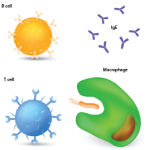2019 Lupus Foundation of America Gary S. Gilkeson Career Development Awards
 Emily Smitherman, MD, assistant professor, pediatric rheumatology, University of Alabama at Birmingham, and Children’s of Alabama, one of four recipients of the Gary S. Gilkeson Career Development Awards, is interested in identifying predictors for differences in disease activity within the pediatric population. To accomplish this, she is taking a step back from traditional patient-level variables.
Emily Smitherman, MD, assistant professor, pediatric rheumatology, University of Alabama at Birmingham, and Children’s of Alabama, one of four recipients of the Gary S. Gilkeson Career Development Awards, is interested in identifying predictors for differences in disease activity within the pediatric population. To accomplish this, she is taking a step back from traditional patient-level variables.
For her study, “Evaluating Disease Activity Outcomes in Childhood-Onset Systemic Lupus Erythematosus,” Dr. Smitherman is delving into the contributions of community and social determinants to health and disease activity. She is using multi-center data from the Childhood Arthritis and Rheumatology Disease Research Alliance (CARRA) to produce a risk assessment tool that could be validated for use in clinical care.
 Erik Anderson, MD, another Career Development grantee, is an Elmezzi Scholar, Elmezzi Graduate School of Molecular Medicine, at the Feinstein Institutes for Medical Research, the research arm of Northwell Health in Manhasset, N.Y. A clinical trial at the Institutes exploring an interferon-α receptor blocker antibody captured his interest as he began his rheumatology fellowship at Northwell.
Erik Anderson, MD, another Career Development grantee, is an Elmezzi Scholar, Elmezzi Graduate School of Molecular Medicine, at the Feinstein Institutes for Medical Research, the research arm of Northwell Health in Manhasset, N.Y. A clinical trial at the Institutes exploring an interferon-α receptor blocker antibody captured his interest as he began his rheumatology fellowship at Northwell.
“There are some studies in people with hepatitis C and cancer developing cognitive and depressive issues after interferon-α [IFNα] treatment, so for my proposal I decided to look further into this interaction with lupus,” Dr. Anderson said.
His study, “Tryptophan Pathway Activation by Interferon-alpha: Impact on Mood and Cognition in SLE,” will measure patients’ levels of the tryptophan metabolites quinolinic acid (QA) and kynurenic acid (KA). The imbalance of these two—QA known to damage neurons and KA known to protect neurons—may contribute to depression and cognitive problems in lupus. The blood tests and brain imaging in this observational study may highlight the tryptophan pathway and IFNα as potential treatment targets.
About the Award
The Gary S. Gilkeson Career Development Awards program is named for the Lupus Foundation of America’s past medical scientific advisory council chair. Dr. Gilkeson is a distinguished university professor and associate dean for faculty affairs and faculty development at the Medical University of South Carolina, Charleston. According to the LFA, the award was designed for fellows and young clinicians to support their early careers as physician scientists. The grants, awarded in September, were funded in part by the John & Marcia Goldman Foundation.
Longitudinal Look at ANA tests
The anti-nuclear antibody (ANA) test is important in helping clinicians make an accurate diagnosis of SLE. Research is now surfacing to indicate the performance of this test varies widely and patterns of ANA levels may change over time. Two of the Career Development Award recipients are looking at longitudinal aspects of ANA testing.
 Emily Littlejohn, DO, MPH, associate staff and clinical assistant professor of medicine, Department of Rheumatologic and Immunologic Disease, the Cleveland Clinic, will use data from the electronic health record to examine how ANA changes in people with lupus over the course of their disease. Her study, “Longitudinal Antinuclear Antibodies Titers from Pre-Clinical to Clinical SLE,” will take advantage of a new method called machine learning to build algorithms that cull likely indicators of early lupus from the health record.
Emily Littlejohn, DO, MPH, associate staff and clinical assistant professor of medicine, Department of Rheumatologic and Immunologic Disease, the Cleveland Clinic, will use data from the electronic health record to examine how ANA changes in people with lupus over the course of their disease. Her study, “Longitudinal Antinuclear Antibodies Titers from Pre-Clinical to Clinical SLE,” will take advantage of a new method called machine learning to build algorithms that cull likely indicators of early lupus from the health record.
Identifying people who present with positive ANA results and following their progress over time may make it possible to create indicators of early risk for lupus. Dr. Littlejohn’s study is modeled after work being done by Dr. Yazdany at the University of California, San Francisco.
“By using big datasets—necessary with a disease like lupus which is rare—we may be able to find undiagnosed or pre-lupus patients,” Dr. Littlejohn says. She will also explore whether the use of hydroxychloroquine affects ANA titers over time. She hopes the findings from her study will close some knowledge gaps regarding ANA trajectories over time and provide data to guide decision making related to ordering the test.
 May Choi, MD, FRCPC, associate director of the lupus cohort at the University of Calgary and Mitogen Advanced Diagnostics Laboratory, Calgary, Alberta, Canada, is exploring variations in the performance of ANA testing methods. Her study, called “LEAAPPS: Longitudinal Examination of ANA Associations, Prevalence, and Performance in SLE,” will be the largest of its kind, testing blood samples and utilizing patient information from 1,300 SLE patients at the time of diagnosis and at three and five years after diagnosis.
May Choi, MD, FRCPC, associate director of the lupus cohort at the University of Calgary and Mitogen Advanced Diagnostics Laboratory, Calgary, Alberta, Canada, is exploring variations in the performance of ANA testing methods. Her study, called “LEAAPPS: Longitudinal Examination of ANA Associations, Prevalence, and Performance in SLE,” will be the largest of its kind, testing blood samples and utilizing patient information from 1,300 SLE patients at the time of diagnosis and at three and five years after diagnosis.
Blood samples will be tested for ANA using four methods to determine which method most often yields a true positive result. The grant will allow Dr. Choi to continue her research and clinical fellowship with the lupus program directed by Karen H. Costenbader, MD, MPH, at Brigham and Women’s Hospital, Boston.
Some advantages of the LEAAPPS study are the large cohort and inclusion of patients from multiple countries, both of which address some of the recruitment challenges presented by a disease as heterogeneous as lupus. This study will help discern more precise information for the diagnosis and management of lupus patients.
Lupus Insight Prize
 Ignacio Sanz, MD, Mason Lowance Professor of Medicine and Pediatrics, and chief of the Division of Rheumatology at Emory University School of Medicine, Atlanta, was awarded the $100,000 2019 Lupus Insight Prize by the Lupus Research Alliance on June 19 at the 19th Annual Meeting of the Federation of Clinical Immunology Societies in Boston. Established in 2016—a merger of the Alliance for Lupus Research, the Lupus Research Institute and the SLE Foundation—the Lupus Research Alliance was created to improve treatments for lupus while advancing toward a cure.
Ignacio Sanz, MD, Mason Lowance Professor of Medicine and Pediatrics, and chief of the Division of Rheumatology at Emory University School of Medicine, Atlanta, was awarded the $100,000 2019 Lupus Insight Prize by the Lupus Research Alliance on June 19 at the 19th Annual Meeting of the Federation of Clinical Immunology Societies in Boston. Established in 2016—a merger of the Alliance for Lupus Research, the Lupus Research Institute and the SLE Foundation—the Lupus Research Alliance was created to improve treatments for lupus while advancing toward a cure.
The Lupus Insight Prize recognizes a major, novel insight or discovery that has the potential to change the paradigm by which we understand lupus and lead to further advances in its diagnosis and treatment. Researchers know that B cells have a role in activation of destructive antibodies. Dr. Sanz and his team are noted for description of a pathway of B cell activation that was well known in mouse models, but had not been well defined in human immune responses.
“Over a period of years,” Dr. Sanz explains, “we followed these B cells that you do not see in normal immune responses. Eventually we understood that they were part of a particular pathway of activation called the extra-follicular pathway, because this does not happen inside the germinal centers.”
In a series of papers over the past few years, Dr. Sanz and colleagues described the components of that pathway and the molecular mechanism that induces the epigenetic regulation of the naive B cells and their resulting contribution to lupus.1
Dr. Sanz formerly conducted his research at the University of Rochester, N.Y. He notes that the demographics of the catchment area for his present appointment at Emory entails access to a larger group of patients who are disproportionately affected by lupus—African Americans. The Georgia Lupus Registry, for which his colleague Sung Lim, MD, MPH, is the principal investigator, “provides a unique opportunity here to really be able to understand this disease,” says Dr. Sanz.
The Lupus Insight Prize is especially rewarding, Dr. Sanz says, because it is a testament to the research community’s recognition of his contribution to how we think about SLE.
Gretchen Henkel is a health and medical journalist based in California.
Reference
- Jenks SA, Cashman KS, Zumaquero E, et al. Distinct effector B cells induced by unregulated toll-like receptor 7 contribute to pathogenic responses in systemic lupus erythematosus. Immunity. 2018;49:725–739.e6.

